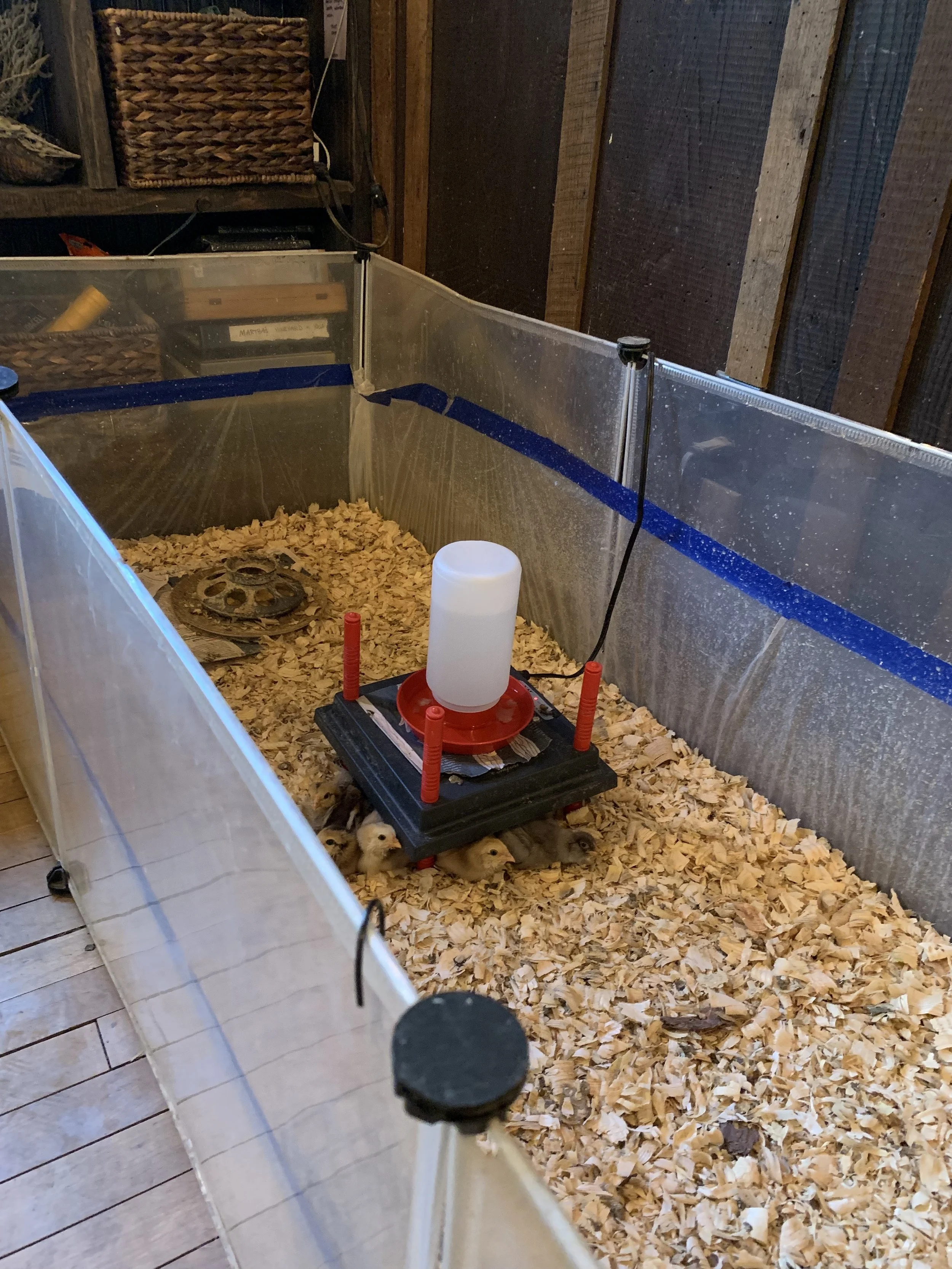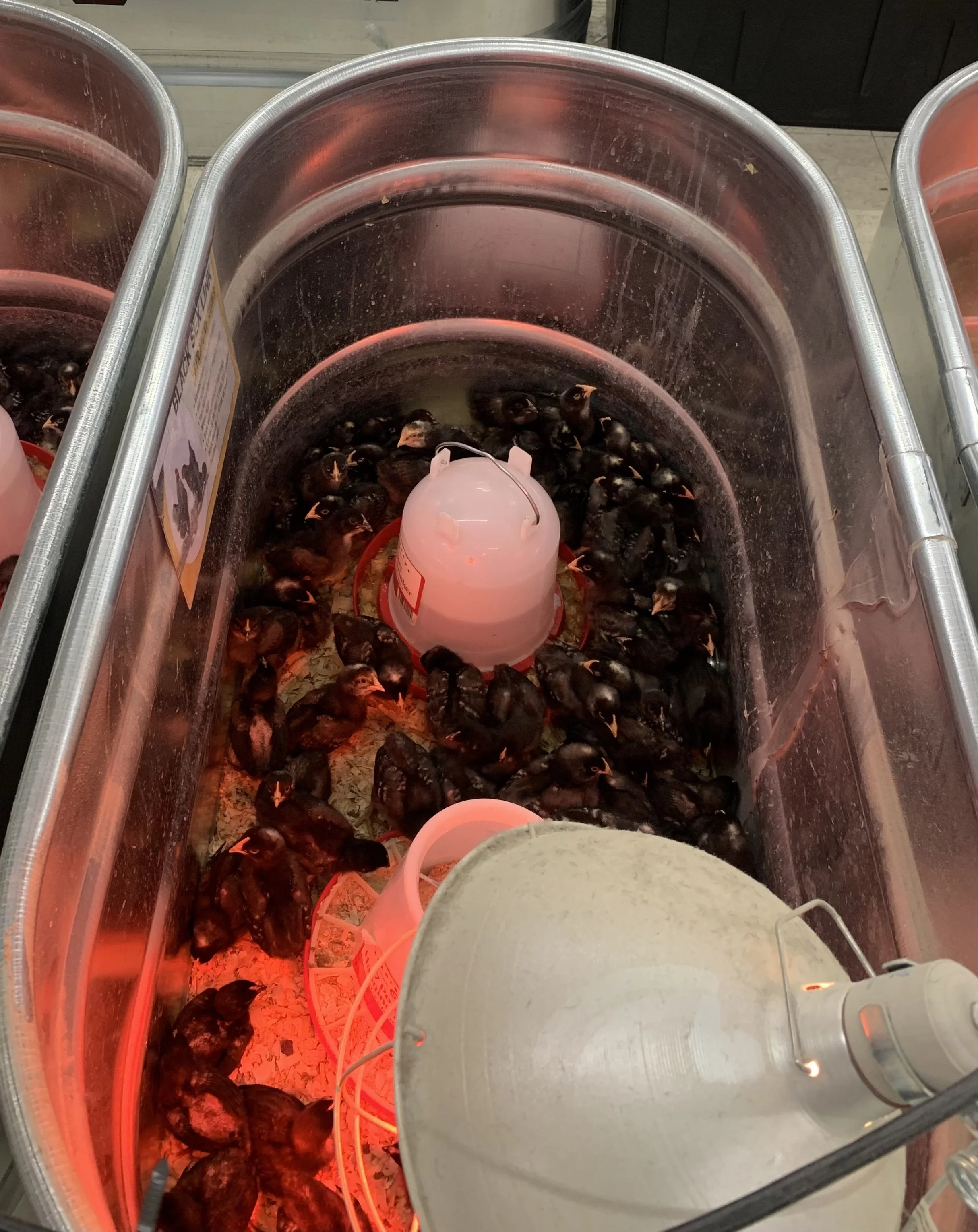How to raise baby chicks!
We get a lot of questions about how to set up a brooder (chick housing) and raise young birds.
As with any type of animal husbandry, there are countless options and no ‘right’ way, but there are a few ‘wrong’ ways that will make you want to pull your hair out. I’ll at least share what has worked and not worked for us when we’ve raised chicks!
-
If you care about ending up with friendly adult birds, you’ll want to brood your chicks somewhere convenient where you will regularly interact with them. The only requirements to think about are safety, inability to escape, climb or jump out, and access to a power source for heat. You will also want solid or at least partially solid sides, otherwise they will kick all of the bedding out.
For most small flocks (10 birds or less) a large, deep tupperware bin or even a large cardboard box could work just fine. Keep in minf that they grow quickly and the more room they have, the less filthy the space will be. We have been using plastic playpen panels which are nice because they can be set up in any size or configuration. The downside is that there is no bottom, so it must be carefully lined with a tarp or something that chicks cannot tear or peck through as they get older.
For whatever type of brooder you choose, you’ll also just want to be able to cover the top with chickenwire or netting after about 3 weeks, as the chicks learn how to hop up. We allow them to do that sometimes when we’re home because they enjoy it so much, but if they’re facing inward, they will poop right out over the edge! :)
-
Here is a simple checklist and explanation of each:
Brooder Plate: Traditionally, many farmers used to use and still utilize heat lamps. After a very close call with a brand new heat lamp bursting and smoldering, we learned our lesson and switched to heat plates. Brooder plates are a significantly better option. They provide more even heat, they satisfy a chicks natural desire to tuck under like they would with a mother hen, they are far safer and more energy efficient, and without a light on 24/7, chicks will begin to regulate their circadian rhythm easier and sleep soundly through the night.
There are many different kinds based on the size of your flock. We use the Producers Pride Brooder Plate because it can easily accommodate larger flocks and it can double as a heater when birds are transitioning outside. Legs on the corners are adjusted to raise the plate every couple weeks or so.
Another great tip is to line the top of the plate with newspaper and use it as a place to elevate the waterer. Chicks can easily hop up to drink, but elevating it will keep bedding out.
Pine Shavings - Be sure to always purchase pine, not cedar. The scent of cedar is far too strong for use with birds, especially young chicks. Using it long-term can create respiratory issues.
Pine usually comes in flake or fine shavings, I always prefer the large flakes because it creates less dust as the chicks scratch.
Feeder - When chicks are teeny tiny (1-2 weeks old) a regular baby chick jar feeder works just fine. As they get bigger and messier, I prefer to use hanging feeders when possible, but the flip top feeders work just as well too and are a better option if you choose to soak or ferment your feed. Otherwise, chicks do so love to scratch the food out or scratch bedding into the food, creating waste.
Waterer - Unlike baby ducklings, chicks are easy and fairly neat when it comes to water! The only thing you want to be aware of is the slim possibility of drowning, so it’s wise to avoid dog dishes or anything open.
You can use a small baby chick waterer for the first few weeks, but I like to switch to a larger 2 or 3 gallon waterer. You also might find that the top of the brooder plate is a perfect place to keep water so that it doesn’t get filled up with bedding.
Apple Cider Vinegar - Organic ACV that contains the Mother has been proven to help support animals digestive system by providing probiotics, which improve overall gut-health and immunity. ACV is a fantastic preventative health measure and chicks/chickens also like the flavor.
You can either add a splash into your chicks drinking water (about a capful per jar or so) or add a splash to soaked and fermenting feed. Soaking feed is a great option to reduce waste and aid in digestion, but if you’re using ACV in the feed, opt for plain fresh water.
Chick Grit - Grit is just finely ground stones that birds need to help them digest food in their crop. It’s very important for chicks since they are not freeranging, but once we put our birds outside with access to dirt and natural stones, we don’t worry about grit.
Be sure to purchase chick grit because adult grit stones are too large for babies. Some people provide grit freechoice in a separate feeder, but I’ve found that chicks will confuse grit for food and overeat it. I just mix in some grit with each feeding. A little sprinkle on top will do just fine.
Chick Food - Often called “Chick Starter,” is usually fed for at least the first 8 weeks. As with any feed, there are tons of different kinds, but here are a few things we’ve learned.
We do not recommend pellets as they are highly processed and tend to contain fillers. In order to compress into the pellet shape, they are also heated above 115º so the loss of nutrients is significant enough that you will actually end up feeding more.
Birds are highly sensitive to pesticides and even more so for young chicks. Exposure to pesticides can result in lameness, paralysis, diarrhea, and mysterious deaths. These chemicals are unfortunately present in many commercial chick feeds when the crops are sprayed with pesticides, so we always suggest investing in organic, non-GMO feed.
We use Nature’s Best Chick Feed.
-
If you’re looking to provide a little bonus stimulation for your babies, they get pretty fun and curious starting at around 2 weeks old! They will love to explore anything they can peck, climb or scratch.
Bird Toys: You can find little bells, danging toys or even chicken xylaphones for your chicks to entertain themselves.
Roosting Poles: Small sticks or twigs can be propped or hung in your brooder area for chicks to hop and perch. They love getting as high as possible!
Laser Pointer: Your chicks will either love or be deathly afraid of a laser pointer. We’ve had great fun playing with some of our flocks this way, while others just never seem to enjoy it!
Dust Bath: Baby chicks LOVE a good dust bath and it’s a helpful instinct to encourage. (Adult birds will make their own dust bathing areas by digging in dry dirt. It is a way that they clean excess oil from their feathers and rid themselves of insects.)
You can use plain wood ash, construction grade sand or dry dirt. Just provide a large pan or bowl for them to get in and enjoy the show!
Cardboard Box: A plain cardboard box is a fun place for chicks to dig and perch. You can sprinkle a bit of food or fresh greens on the bottom for them to scratch.
-
If you have a good, safe heat source, and an enclosed space, chicks can go outside from day 1 or whenever they start to drive you crazy. For us, that time frame is usually 5-6 weeks. That’s when they really start to experiment more with hopping and flying around, and typically are ready for more space.
If it’s cold where you live when your chicks are young, it’s still beneficial to let them outside for short periods of time each day. If you have any sort of portable run, a covered porch or playpen, exposing them to weather little by little will help them adjust to being outdoors and also helps their feathers to grow in faster.
By around 7-8 weeks, chicks are fully feathered and can regulate their own body temperature well. They will no longer need heat at all, and you will actually not be doing them any favors by providing it beyond that point. Chickens are very cold tolerant but need to learn how to adapt early on. If heat is always provided, they become lethargic and unwilling to forage or leave the coop in inclement weather. You’ll want your birds to connect to your climate naturally so that they are more comfortable and hardy, and so that they learn to molt at appropriate times.
-
The best way to integrate your chicks into the rest of your flock is gradually. Usually it’s best if the chicks can be kept separate but exposed to the rest of the flock as they grow. Any sort of enclosure or separation is pretty much necessary until your chicks are about the same size as your adults.
At that point, we usually start supervised freeranging time for the last few hours of the day. That way, birds can easily get away from one another if they feel threatened, but still begin to establish their pecking order.
From there, time can just gradually be increased and watch for any signs of bullying. It really is different for every flock, but we’ve never had much trouble.
Once birds are regularly spending full days together, you can start incorporating them into the same coop at night. You’ll most likely have to wrangle your chicks into the correct housing each night for a while. If you don’t have any sort of enclosed run, you might want to invest in a good poultry net. Godspeed. ;)
Here is an example of inappropriate brooding conditions.
The water and feed are directly on the floor. Both are filled with feces and bedding.
This bin would be sufficient for about 12 chicks. These are extremely overcrowded and inhumane conditions.
This heat lamp is unsafe and insufficient for the quantity of birds.
There is no grit supplied.
I hope this helps you to feel equipped and get everything ready for your new babies. If you think of any other questions I might have missed, please ask below and I will amend this post for future reference!
Thanks for reading,
Rosslyn

